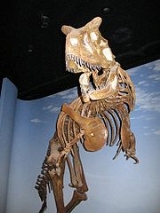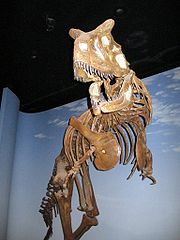
La Colonia Formation
Encyclopedia
The La Colonia Formation is a geological formation in Argentina
whose strata date back to the Late Cretaceous
. Dinosaur remains are among the fossils that have been recovered from the formation.
Originally thought to be Campanian
in age or earlier, studies of underlying formations have made a Maastrichtian
(70-65 million years ago) age more likely.
Argentina
Argentina , officially the Argentine Republic , is the second largest country in South America by land area, after Brazil. It is constituted as a federation of 23 provinces and an autonomous city, Buenos Aires...
whose strata date back to the Late Cretaceous
Late Cretaceous
The Late Cretaceous is the younger of two epochs into which the Cretaceous period is divided in the geologic timescale. Rock strata from this epoch form the Upper Cretaceous series...
. Dinosaur remains are among the fossils that have been recovered from the formation.
Originally thought to be Campanian
Campanian
The Campanian is, in the ICS' geologic timescale, the fifth of six ages of the Late Cretaceous epoch . The Campanian spans the time from 83.5 ± 0.7 Ma to 70.6 ± 0.6 Ma ...
in age or earlier, studies of underlying formations have made a Maastrichtian
Maastrichtian
The Maastrichtian is, in the ICS' geologic timescale, the latest age or upper stage of the Late Cretaceous epoch or Upper Cretaceous series, the Cretaceous period or system, and of the Mesozoic era or erathem. It spanned from 70.6 ± 0.6 Ma to 65.5 ± 0.3 Ma...
(70-65 million years ago) age more likely.
Flora
Fossil leaves and fruits assignable to Nelumbonaceae have been found in the Cañadón del Irupé locality of the La Colonia Formation.Turtles
| Turtle Turtle Turtles are reptiles of the order Testudines , characterised by a special bony or cartilaginous shell developed from their ribs that acts as a shield... s reported from the La Colonia Formation |
||||||
|---|---|---|---|---|---|---|
| Genus | Species | Location | Stratigraphic position | Material | Notes | Images |
Patagoniaemys Patagoniaemys Patagoniaemys is an extinct genus of stem turtle which existed in central Patagonia, Chubut Province, Argentina during the late Cretaceous epoch . It is known from skull fragments and several postcranial elements including a nearly complete vertebral column recovered from the La Colonia Formation.... |
P. gasparinae |
"skull fragments and several postcranial elements including a nearly complete vertebral column." |
||||
Mammals
Over 300 mammal specimens have been found in the La Colonia formation.| Mammal Mammal Mammals are members of a class of air-breathing vertebrate animals characterised by the possession of endothermy, hair, three middle ear bones, and mammary glands functional in mothers with young... s of the La Colonia Formation |
||||
|---|---|---|---|---|
| Taxa | Presence | Notes | Images | |
Argentodites coloniensis Argentodites Argentodites is a possible multituberculate mammal from the Cretaceous of Argentina. The single species, Argentodites coloniensis, is known from a single blade-like fourth lower premolar from the La Colonia Formation, which is mostly or entirely Maastrichtian in age... |
A possible gondwanatheria Gondwanatheria Gondwanatheria is an extinct group of mammals that lived during the Upper Cretaceous through the Eocene in the Southern Hemisphere, including Antarctica... n or multituberculate. |
|||
Reigitherium bunodontum Reigitherium Reigitherium bunodontum is a mammal that lived during the Late Cretaceous . Fossils of it have been found in the Los Alamitos and the La Colonia Formations of Argentina.... |
||||
Dinosaurs
| Dinosaur Dinosaur Dinosaurs are a diverse group of animals of the clade and superorder Dinosauria. They were the dominant terrestrial vertebrates for over 160 million years, from the late Triassic period until the end of the Cretaceous , when the Cretaceous–Paleogene extinction event led to the extinction of... s reported from the La Colonia Formation |
||||||
|---|---|---|---|---|---|---|
| Genus | Species | Location | Stratigraphic position | Material | Notes | Images |
Carnotaurus Carnotaurus Carnotaurus was a large predatory dinosaur. Only one species, Carnotaurus sastrei has been described so far.Carnotaurus lived in Patagonia, Argentina during the Campanian or Maastrichtian stage of the Late Cretaceous... |
C. sastrei |
"Complete skeleton and skull." |
An abelisaurid Abelisauridae Abelisauridae is a family of ceratosaurian theropod dinosaurs. Abelisaurids thrived during the Cretaceous Period, on the ancient southern supercontinent of Gondwana, and today their fossil remains are found on the modern continents of Africa and South America, as well as on the Indian... . |
 |
||

